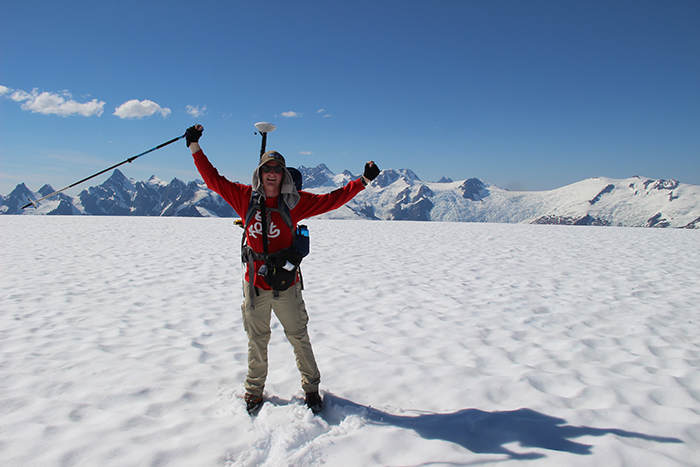Tracking Change

James Fisher '18 in British Columbia, where he gathered data as part of a student-faculty-alumni research team.
James Fisher ’18
Growing up on a farm, James Fisher ’18 developed a keen appreciation for wildlife and the great outdoors, and after he took his first earth sciences class at Dickinson, he discovered a way to combine that interest with his love of science. This summer, he took part in two student-faculty research projects, including a field research trip to British Columbia, where he helped Professor of Earth Sciences Ben Edwards collect data about the effects of climate change on a volcano and the glaciers that flank it. Below, he discusses what he enjoyed about that work and how it ties in to his senior research and post-Commencement plans, as well as his experiences in Norwich, England.
Major:
Clubs and organizations:
Men’s Club Soccer (president) and Geology Club (vice president). I am also a departmental lab assistant and teaching assistant.
Honors/scholarships/awards:
Robert Allan Jansen Memorial Student-Faculty Research Award, Henry Hanson Research Prize in Geology and Dean’s List.
Favorite book:
The Hobbit by J.R.R. Tolkien.
Favorite movie:
2001: A Space Odyssey.
Favorite professor:
My favorite professor is my advisor, [Associate] Professor [of Earth Sciences] Pete Sak. His care for his students is apparent both inside the classroom and out. Pete will go out of his way to help individual students by staying late to answer questions, clarifying topics in class and making himself available to students even when he is not on campus.
Favorite place on campus:
Kaufman Hall.
Favorite Dining Hall food:
Mac & cheese from the Kove with sriracha.
On choosing a major:
Growing up working on a farm, I developed an appreciation for wildlife and the outdoors. During my first semester at Dickinson, I took Planet Earth with Professor Sak; I loved how the class connected what I saw in nature to scientific processes. At the end of the semester, I decided that earth sciences was the right major for me. Since then, my earth sciences major has given me opportunities to travel to remote places like the Alaskan bush and the Canadian backcountry.
Post-Dickinson plans:
I plan to attend a graduate school and study geomorphology, the study of how landscapes change over time due to processes like climate change, erosion and others.
As a kid, I wanted to be …
… either a chef or a racecar driver.
Proudest accomplishment so far:
Earning the Eagle Scout Award.
On studying abroad:
I spent the fall 2016 semester studying at the University of East Anglia in Norwich, England. For the first three weeks, our group lived in downtown London. We visited museums and landmarks and attended performances and concerts in iconic venues like the Globe Theatre and the Royal Albert Hall. Living in a cultural and economic metropolis like London for three weeks was a once-in-a-lifetime experience.
If I could have dinner with anyone, living or dead, it would be …
… Jurgen Klopp, the coach of my favorite soccer team.
Favorite class/learning experience:
A research expedition this past summer to British Columbia, Canada. Three other earth science majors and I assisted Professor [of Earth Sciences] Ben Edwards and Will Kochtitzky ’16 with field measurements and data collection. The main goal of our expedition was to document climate change on the Hoodoo Mountain volcano and two surrounding glaciers in western British Columbia. On this trip, I learned how to conduct fieldwork for research and gained a greater appreciation for the breathtakingly pristine landscape that is being altered, year by year, due to climate change. I got involved with this project because I really enjoyed Structural Geology with Professor Pete Sak. During my junior year, I reached out to Pete to be my research advisor, and he suggested this research as a possibility. I read some papers on the subject and wanted to learn more, so I chose this project as my senior capstone research project.
About this research:
Around 250 million years ago, what we know today as the continent of Africa collided with North America, creating the Appalachian Mountains. The goal of my research is to create a diagram that maps how rocks were broken and deformed below the surface, through the central Appalachian Mountains in Pennsylvania. The model I am developing will help geologists better understand how the Appalachian Mountains formed. Performing this research has taken my earth sciences education to the next level. I now understand geologic vocabulary and have learned to develop hypotheses based on data and observations. Drafting my diagram of subsurface geology is like a solving giant jigsaw puzzle; it has greatly improved my problem-solving skills.
Biggest influence:
My grandfather. He had a great sense of humor and taught me never to take myself too seriously.
Most important thing I’ve learned so far:
Always push yourself to be the best that you can be.
Learn more
- “Down-to-Earth Investigations”
- Department of Earth Sciences
- Research at Dickinson
- Grants and Scholarships
- More Student Snapshots
- Latest News
Published August 28, 2017